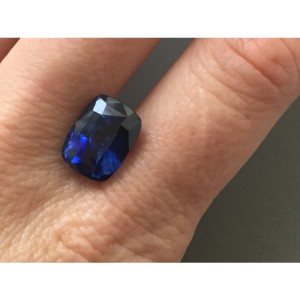October 7, 2014 there was an unbelievable event in New York, when the cost of blue sapphire was reached 404 236 US $ per carat at “Sotheby’s” auction. Non-heated gemstone of “Cornflower blue” color 17,16 carat was mined in Kashmir, a historical storehouse of the best sapphires in the world. AGL, SSEF and Gubelin issued a gemological report for this unforgettable stone…
Noble blue sapphires today are one of the most popular gemstones in the world. Let’s see necessary information that every person should know when choosing this gem of kings.
There is no doubt, that sapphires color is the main factor of their natural beauty. Classic stones are characterized with the following colors: blue, light blue and blue with violetish or greenish tinge. The brighter the color of sapphire is the more its cost is. The most desirable stones are vivid and deep blue without any additional tones. There are two top commercial colors in international trade: “Royal blue” and “Cornflower blue”. The first color is considered to be the most expensive one. It is the best stone for Asian market or for countries with sunny days the whole year. In less sunny, cloudy areas jewelers do not choose gems of this color because they often appear to be almost black.
In addition, untreated sapphires are more expensive than treated ones and also they usually have a gemological report, which confirms this information. Besides, the cost of unheated sapphire is 1,5-2 times higher than the price of a similar heated one.
Moreover, gemstones’ country of origin has also influence on their cost. The best breathtaking blue sapphires have historically been mined in the North of India in Kashmir, but at the moment the exploitation of this field has been stopped.
That is why it is very difficult to find Kashmir stones, now they are sold by auctions. A deep blue and a velvety play of color are more typical for Kashmir sapphires mainly due to rutile inclusions. Keep in mind that the word “Kashmir” sapphires is used not only for indicating the field, but also to describe a typical “Kashmir” color, and the stone itself may have a different origin. The second place for their value occupy blue sapphires from Myanmar (Burma), then the stones from Sri Lanka island (Ceylon). The delivery of sapphires of excellent blue color from Madagascar has started recently.
Finally, to confirm natural origin, as well as carry out a diagnostics of treatment, determine fields and ‘brand’ color, dealing with expensive sapphires it is necessary to order a gemreport from independent gemological institute. Some of the most reputable laboratories are the GIA, Gubelin Gem laboratory, SSEF and AGL. At the Asian market gemological reports from a famous Swiss laboratory GRS are also very popular at a sale of gems.

